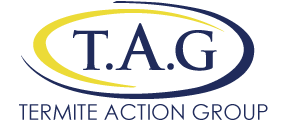About TAG
The Termite Action Group, known by the acronym TAG, was initially formed in 1999 as a community action group in response to termite problems being experienced by Homeowners in Forest Lake, Brisbane, Australia.
The suburb of Forest Lake was particularly prominent in having termite problems due to factors such as zero allotments, poor construction methodologies and covenants pertaining to green areas for trees, shrubs and gardens that encouraged termite activity.
It was also discovered from many and varied discussions, that the major preconstruction pest management company providing treatments for the major project home builders, Guardian Weed and Pest Control, was not providing chemical barrier treatments in compliance with the applicable Standard.
Several well attended community meetings were held that demonstrated the length and breadth of the problem being experienced throughout the wider community.
TAG Initiatives
The group co-ordinator of TAG, Mr. Andrew M. Campbell, took on the project of identifying the problems that beset the pest management industry and the building industry.
This involved the task of travelling throughout Australia and identifying problems experienced in each state and territory, to evaluate systems and products used in pest management and relating this to the various differing building methodologies used in the construction of homes.
The inter-relationship between building systems and pest management appeared to be an extremely random process with inadequate forethought given to an integrated approach to the problem.
The problems being experienced by Homeowners were systemic and ingrained providing a sense of hopelessness to those afflicted with termite problems.
TAG dealt with many bureaucracies to find that whilst they all frequently discussed the ‘rights of the consumer’, they either failed to uphold their rights or worked deliberately against the best interests of consumers.
The situation was heavily weighted against the consumer and TAG went on to assist them by exposing the complete and utter failure of both the building provisions and the regulatory system.
The failure was systemic and involved both public and private sector collusion which subjugated the rights of ordinary Australian Homeowners and Property Investors thereby putting their major investments at complete and ongoing risk.
Chemical Systems
Throughout Australia, there emerged problems with the use of chemical treatments for differing reasons such as under-spraying or over-dosing of sites, and a preconstruction market with little or no checks and balances on the use of chemical termiticides.
Builders were able to pay minimal prices to get a certificate that falsely stated that a chemical barrier had been installed in accordance with the Australian Standard.
Often the price of an application was less than the wholesale cost of the chemicals required to complete the job to the requirements of he Standard. This generally resulted in homes having little or no protection against termites.
As a result of these illicit practises, people quickly lost confidence in chemical barrier systems. However, if the chemicals were not in place, they were obviously never going to work!
Many problems were to occur with Reticulation Systems that carried the chemistries into soil mediums. Even more problems were to emerge with the soil mediums that were supposed to contain the chemistries.
The problem was that only chemicals killed termites!
Physical Systems
There was a massive upsurge in the introduction of physical termite management systems that included graded stone, metal sheet, plastics and glass that were integrated into the internal perimeter cavity of ‘slab on ground’ design homes.
Often these products and systems were poorly researched and the benefits were massively overstated by manufacturers and installers. The term ‘termite barrier’ was adopted as a descriptor whereas these systems were, by definition, ‘termite monitoring systems’ at very best.
The truth was that these systems could be ‘bridged’ in a day whilst the inspection regime was generally an annual event and there was no warranty provided for ‘bridging of the system’.
The ‘termite barrier’ status allowed physical systems’ manufacturers and installers alike, make spurious claims of ‘termite protection’, thereby misleading Homeowners as to the true and limited function of these systems.
In Closing
The preconstruction side of the termite management industry is performing so badly that it is now creating massive volumes of remedial works in the post-construction area of termite management.
This is clearly evidenced by the spiralling growth rates in this sector and the upsurge in the number of termite management vehicles on the road to treat the burgeoning problem.
Many victims of termite damage, and the dreadful costs in treatment and repairs and devaluation of home values, have great difficulty in understanding the multitude of issues involved.
Ten different termite technicians can provide ten different methodologies from chemical barrier treatments, dustings, bait stations, sprays, monitoring systems, etc. The costs can be horrendous and the result entirely unsatisfactory and ineffective as you will probably still be ‘living at risk’ of termite attack.
The TAG website has been designed to try to assist and educate ordinary Australian Homeowners and Property Investors by providing an understanding as to how best to understand termite issues and best defend your homes and buildings against termite damage.
It is also a resource of documentation to clearly evidence the complete failure of bureaucracy and regulatory process.
TAG hopes that the content of this website is informative and of assistance in providing education on termite management.


3 Comments (Leave a Reply)
Hello
Just want to comment on your excellent website. Great for the public to have access to a well-informed, unbiased website about termites. We would love to place a link from our website to TAG’s
Thnks Rowan
You are welcome to place a link through to the TAG website as an information resource for Homeowners.
Some truly prime blog posts on this website , saved to fav.